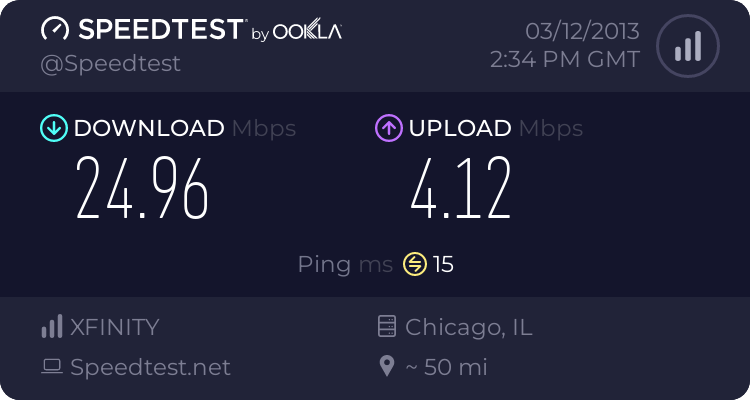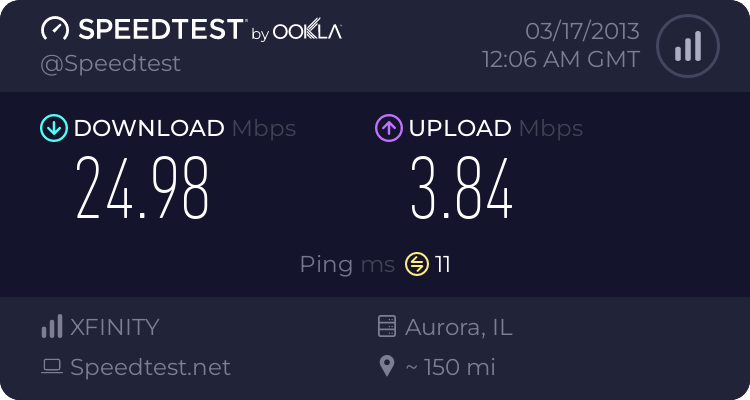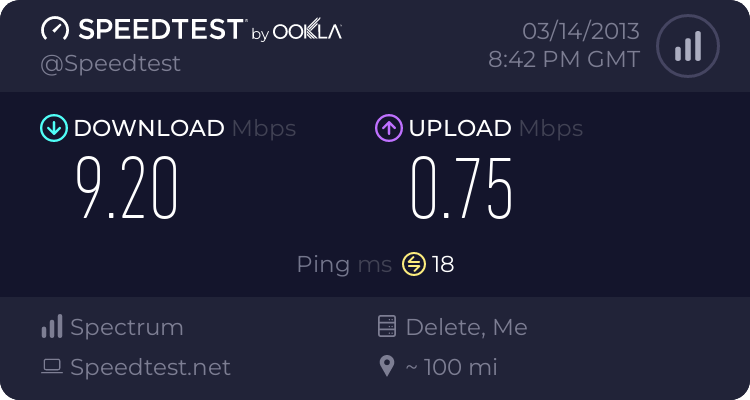You are using an out of date browser. It may not display this or other websites correctly.
You should upgrade or use an alternative browser.
You should upgrade or use an alternative browser.
Motorola SurfBoard SB6141 Cable Modem DOCSIS 3.0
- Thread starter electron
- Start date
pete_c
Guru
Interesting today my speeds dropped to 14Mb/s after seeing the 25Mb/s speeds for a couple of days.
Originally when I installed new D3 modem:

Today with new D3 modem:

Diagnostics show good D3 signals.
The online chat technician bounced my modem like 10 times with no good results.
Funny too that I also posted on the CC forum and a tech there said that the online chat folks do not know what they are doing.
A ticket though was opened to escalate issue to next level customer support.
Initially it sounded like a truck role; which personally would be a wasted effort considering my hardware is fine.
Originally when I installed new D3 modem:

Today with new D3 modem:

Diagnostics show good D3 signals.
The online chat technician bounced my modem like 10 times with no good results.
Funny too that I also posted on the CC forum and a tech there said that the online chat folks do not know what they are doing.
A ticket though was opened to escalate issue to next level customer support.
Initially it sounded like a truck role; which personally would be a wasted effort considering my hardware is fine.
pete_c
Guru
Interesting. CC forum techy asked me to run a program from this link:
http://www.cc.gatech.edu/~partha/diffprobe/shaperprobe.html
My results were:
If I understand right it appears that CC is tweaking down my internet speed with the D3 modem.
Signal strength is good on D3.
http://www.cc.gatech.edu/~partha/diffprobe/shaperprobe.html
My results were:
DiffProbe release. January 2012. Build 1008.
Shaper Detection Module.
Connected to server 213.244.128.168.
Estimating capacity: Upstream: 4304 Kbps. Downstream: 25608 Kbps.
The measurement will take upto 2.5 minutes. Please wait.
Checking for traffic shapers:
Upstream: Burst size: 4899-4983 KB; Shaping rate: 2090 Kbps.
Downstream: Burst size: 12973-13543 KB;
Shaping rate: 12320 Kbps
If I understand right it appears that CC is tweaking down my internet speed with the D3 modem.
Signal strength is good on D3.
Attachments
pete_c
Guru
Wierd but CC closed my ticket from this morning and never sent me a transcript. First time I have seen this before.
The CS appeared to be setting up a truck roll though to "fix" my modem?
diffprobe shows:

The CS appeared to be setting up a truck roll though to "fix" my modem?
diffprobe shows:
Checking my speeds now and see:DiffProbe release. January 2012. Build 1008.
Shaper Detection Module.
Connected to server 203.5.76.164.
Estimating capacity:
Upstream: 4112 Kbps.
Downstream: 25000 Kbps.
The measurement will take upto 2.5 minutes. Please wait.
Checking for traffic shapers:
Upstream: Burst size: 4546-4613 KB;
Shaping rate: 2128 Kbps.
Downstream: Burst size: 9613-10080 KB;
Shaping rate: 15978 Kbps.
For more information, visit: http://www.cc.gatech.edu/~partha/diffprobe

pete_c
Guru
Smarty,
What were your speeds before the updated modem? Your upload/download speeds are low. Think the slowest tier now is 6/3.
Dan,
I think the pricing is relative. It appears that mostly everyone's pricing went to the same amount and that the pricing was set up one way for those that just pay for internet and those that pay for bundling. As they have been implementing D3 their pricing has been changing accordingly. Mostly folks do not pay attention and see it as internet or no internet.
CC was sued for 800k to keep the prices for just internet the same whether you were bundling or not. That said they paid the 800K and did not admit fault. They do offer now a 6 month deal on internet and the pricing is still less when you bundle it with TV service.
This is similiar to pairing up phone service with DSL. Where as the telco's made you get phone service when getting DSL. I think today you can get it like that.
What were your speeds before the updated modem? Your upload/download speeds are low. Think the slowest tier now is 6/3.
Dan,
I think the pricing is relative. It appears that mostly everyone's pricing went to the same amount and that the pricing was set up one way for those that just pay for internet and those that pay for bundling. As they have been implementing D3 their pricing has been changing accordingly. Mostly folks do not pay attention and see it as internet or no internet.
CC was sued for 800k to keep the prices for just internet the same whether you were bundling or not. That said they paid the 800K and did not admit fault. They do offer now a 6 month deal on internet and the pricing is still less when you bundle it with TV service.
This is similiar to pairing up phone service with DSL. Where as the telco's made you get phone service when getting DSL. I think today you can get it like that.
pete_c
Guru
Interesting about Time Warner. In FL I switched from Jones Cable to Verizon FIOS. That said most of the neighbors had problems with HD cable where I live and complained to CC because they were paying for HD but really couldn't get it due to the infrastructure.
That said CC redid the cabling on our block such that the neighbors could get HD. The cabling though was like 30 or more years old and run between telephone poles. They did put the cabling underground when they changed it. I think though most of the block went to Verizon FIOS though because they still had problems with CC cabling.
That said CC redid the cabling on our block such that the neighbors could get HD. The cabling though was like 30 or more years old and run between telephone poles. They did put the cabling underground when they changed it. I think though most of the block went to Verizon FIOS though because they still had problems with CC cabling.
whiskeychief
New Member
Dan, thanks for the posting. I just ordered a Motorola 6141 for a new house. I'm pretty sure my local cable operators are Docsis 2.0-only so far, but it will be good to be future-proof. Tnx.
Welcome to CT!
Do you use Time Warner? Wondering if there is an easy way of telling (via http://192.168.100.1 modem logs maybe?) what standard they are using in certain areas.
Do you use Time Warner? Wondering if there is an easy way of telling (via http://192.168.100.1 modem logs maybe?) what standard they are using in certain areas.
pete_c
Guru
I was able to tell (actually via a broadband/cable tech on CC forum) because of the channel bonding I saw (pictures above).
http://forums.anandtech.com/showthread.php?t=2145569
The CM configuration file I saw in the logs downloaded is using the surfboard D3 modem in its name. The "silver" piece though is the old naming conventions for the older Comcast internet speed tiers.
A bit more info (maybe too much?)
http://www.highspeedexperts.com/know-your-docsis/
Keep in mind that the difference between DOCSIS 2.0 and DOCSIS 3.0 was only two things: channel bonding for both the upstream and the downstream, and support for QAM128 for the upstream. Downstream both use QAM256 so the maximum downstream throughput for a single 6MHz channel is 42Mb. QAM64 upstream is 30Mb, and QAM128 should be something like 35Mb (I don't have the specific number in front of me), but I've never seen anyone use QAM128. So for all practical purposes the only difference is channel bonding.
Given that most services are still well below 42/30, the advantage to channel bonding isn't really throughput, it's load balancing. DOCSIS 2.0 only supports a single channel, so 2-3 users on a fast connection can easily saturate a 6MHz channel. Since DOCSIS can't seamlessly reallocate on the fly (DCC requires a modem retrain), you're basically stuck with the people on your channel, so you better hope not everyone is trying to use their connections at once.
With channel bonding on the other hand, you'll be using 3-4 channels. The worst case scenario (everyone on the service trying to max out their connection) is still the same, but with a larger pool of users the average isn't as bad because your connection can't be dragged down by a very small number of the wrong people. Thus performance is more consistent on average. In the long run of course this enables higher performance beyond 42/30. The secondary benefit is that with systems like PowerBoost, bonded channels mean not only can users boost higher, but for the same reason that bonding benefits the average speed, bonding makes it easier to boost big by siphoning a bit of bandwidth off of multiple channels.
It's because we're talking about the average case however that not everyone sees immediate benefits. Most users with PowerBoost available should see some kind of benefit, otherwise the biggest benefit will be for those users with a particularly unlucky channel allocated to them. And of course this assumes a DOCSIS 3.0 headend; none of these benefits would be seen with a DOCSIS 2.0 headend.
http://forums.anandtech.com/showthread.php?t=2145569
The CM configuration file I saw in the logs downloaded is using the surfboard D3 modem in its name. The "silver" piece though is the old naming conventions for the older Comcast internet speed tiers.
SW Download INIT - Via Config file d11_m_sb6141_silver_c01.cm
A bit more info (maybe too much?)
The term DOCSIS, itself an acronym for Data Over Cable Service Interface Specification, is something that many techies and broadband junkies talk about nearly endlessly, often in excited and/or argumentative tones. Since its initial release in 1997, DOCSIS has been better known as the technology behind cable broadband services. Different variants of the DOCSIS standard are used by different broadband providers, which may confuse some consumers and put some on quest to understand their broadband options better. The existence of multiple DOCSIS standards makes for a slightly steeper learning curve, which unfortunately impairs the ability of consumers to make the best possible purchasing decision. After all, how can one decide which path to broadband is best for them if they do not even understand the fundamental terminology being used?
There are three different levels of DOCSIS specifications, 1.x, 2.x, and 3.x, each one tends to improve performance and/or offer additional features over the last. This means that 3.x tends to be a better standard than 2.x, which in turn is generally better than 1.x. There are a few exceptions to this, and of course a working definition of ‘better’ would probably be helpful. Some areas serviced by second-tier cable companies still use older DOCSIS 1.x systems, but most top-tier providers using 3.x, but tend to charge more money for greater performance. For the purposes of fostering a productive discussion on the subject, greater features and performance will generally be considered ‘better’ than great value. After all, prices for the same level of service tend to fall over time and thus value is relative and highly dependent upon time.
DOCSIS Gets Physical
The DOCSIS specification can be broken down into at least two layers, the physical layer (PHY) and the media access control (MAC) layer. The physical layer is the easiest to understand as it refers to things that people can see and touch, in this case wiring and routing equipment. The physical layer also specifies of the frequency at which data is transmitted over the wires of a cable modem system and DOCSIS-compliant network. The faster the transmission speeds, the greater the performance tends to be, but there are limitations on distance. Limitations on distance restrict the areas in which DOCSIS-based cable modem services can be deployed, their speed, and their pricing.
Meet DOCSIS’s Other Layer, the MAC
The MAC layer is used to handle the massive packet switching requirements of a cable network and ensure that there are fewer traffic jams caused by signals colliding. In effect, the MAC layer is something of a traffic-cop that helps maximize the performance of a network. Not all MAC layers are created equal, however, and understanding how MAC affects a major network is important. Unfortunately, understanding the MAC layer is easier said than done.
Think of the problem faced by network architects this way: imagine data on a DOCSIS network as a car, and the network itself to be the layout of streets in a major metropolitan area, but dominated by a single major avenue onto which all traffic merges at some point. Now imagine this complex crisscross of city streets accelerated via time lapse photography, at a pace that turns each minute into a fraction of a second; one side of a traffic light bursts then stops followed by vehicles traveling in the opposite direction. The only thing that brings order to what would otherwise be chaos is the system of traffic lights that the vehicles attempt to obey, and they do not always work 100% of the time. This is not very different from how networks function, even DOCSIS-based systems.
There are dozens, perhaps hundreds of homes within a housing sub-division that are serviced by dedicated DOCSIS networking hardware provided by the broadband service provider. There is no guarantee that only a single sub-division is serviced by one terminal, but for the purposes of education, the example should suffice. Each device has its own specific address and name, referred to as an IP address and MAC address respectively. The MAC address is used for intra-network signal timing rather than actual data transmission and reception. This would make MAC addresses similar to traffic lights that exist at each customer’s cable modem router and the cars akin to packets of data. The central computer system in any city the controls the traffic lights would be the DOCSIS hardware devices that are deployed across the country, serving consumers and businesses alike.
Understanding the Different DOCSIS Specifications
The original DOCSIS 1.0 standard offered support for a single channel, a trend that continued up until the introduction of the most recent DOCSIS standard, DOCSIS 3.0. The differences between DOCSIS 1.0 and 1.1 are mostly academic, and relate to the number of consumers that can be serviced and their range from hardware operated by a cable provider. The official throughput for DOCSIS 1.x systems was limited to a usable 38 Mbps downstream and approximately 9 Mbps of upstream. These rates are shared amongst multiple consumers in most cases, and are practical. Some hosts provide higher specs, specifically 42.88 Mbps downstream and 10.24 Mbps upstream, but these fail to calculate network overhead and are not necessarily honest figures.
As competition with DSL and other forms of broadband surged post-Y2K, a new standard was needed to deliver greater speeds to a greater number of consumers who were believed to be using upstream and/or downstream numbers as a guide to making purchasing decisions. A standard that offered substantially higher bandwidth, and that standard became known as DOCSIS 2.0 and eventually DOCSIS 2.0 + IPv6. DOCSIS 2.0 actually kept the already impressive downstream speeds, but tripled the upstream performance to 27 Mbps. The logic behind this decision was simple: take a 100 customer region as an example. How many of these consumers are downloading at full-speed at any given moment? If individual download speeds are capped at 9 Mbps, then 4 could be using every last iota of network performance. Of course, what are the chances that consumers or businesses could even find something that would tax 9 Mbps of downstream for any sustained duration?
It quickly became apparent that usage patterns pointed out that downstream speeds were already sufficient, but more customers could be serviced by increasing upstream speeds; the disparity between DOCSIS 1.x’s 38 Mbps downstream and 9 Mbps upstream was too great, but DOCSIS 2.x’s ratio of 38/27 Mbps was more desirable. Of course, the advances made by DSL providers and fiber optics would eventually cause the birth of DOCSIS 3.0.
What makes DOCSIS 3.0 different from its predecessors is that it is able to support multiple channels and bind them together to increase performance. More channels means greater speed, and there is a 4-channel minimum requirement for DOCSIS 3.0 approved hardware. Each channel offers a familiar 38 Mbps downstream and 27 Mbps upstream, but there are no limits to how many channels can be used. This opens up a lot of performance possibilities, a great example of which is the 100 Mbps DOCSIS 3.x service available Comcast is offering business customers in selected areas. Of course, a DOCSIS 3.0 cable modem with 4 channel support is theoretically capable of downstreams greater than 100 Mbps, but it is only a matter of time until faster services are deployed that will be capable of utilizing more channels effectively. Customers would do well to match the right DOCSIS 3.0 cable modem to the appropriate service, or risk paying for a broadband service that they are not fully capable of utilizing.
http://www.highspeedexperts.com/know-your-docsis/
Similar threads
- Replies
- 3
- Views
- 10K
- Replies
- 0
- Views
- 1K



